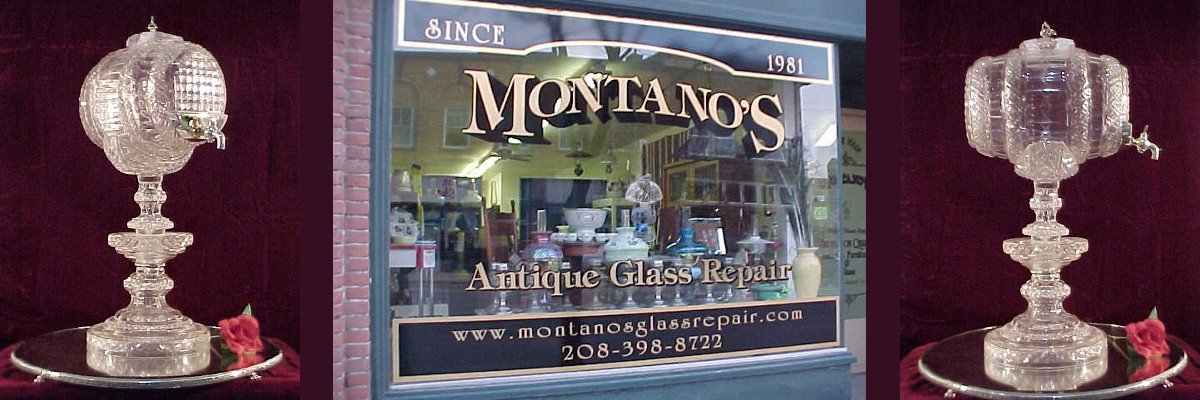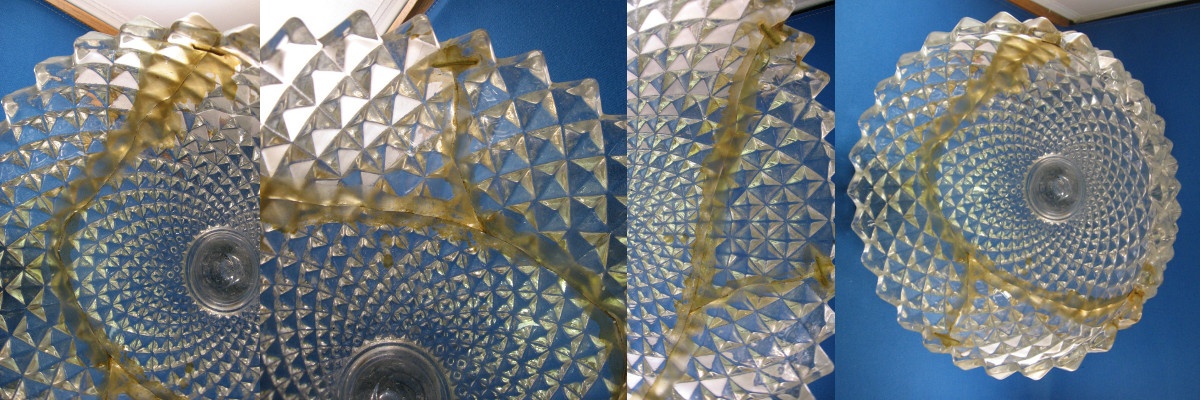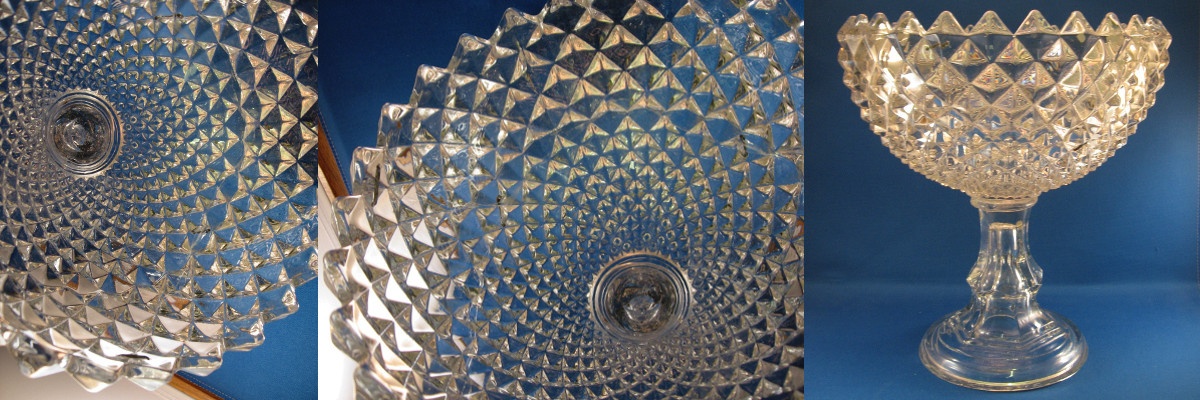[efaccordion id=”01″]
[efitems title=”How do you repair glass?” text=”There are many different ways and methods to repair glass. The most common method is to reduce the height by grinding. Let us use a goblet as an example: the top edge is chipped. The top edge is ground evenly all around, the edges on the inside and outside are rolled to remove the last 10% of the damage. We are very proud of our rolled edges. The edges are not sharp. As far as we know we are the only repair service that takes the time to provide this type of edge. The final step is to polish to the original clarity or better. Goblet tops start at $14. Chipped bowls and vases can be repaired in the same way. Charges start at $24 for bowls and vases.”]
[efitems title=”What about base chips on a goblet?” text=”Base chips on goblets are ground evenly all around and polished to the original clarity without a repair line showing. Repair cost is $16. Large bases such as compotes and footed bowls start at $32.”]
[efitems title=”What if a stem is severely damaged?” text=”If a stem is severely damaged (sections missing) we can cut and level, eliminating the damage and shorten the item. A goblet cut and level is $32 and $48-$72 for larger items, such as compotes. If the bowl and stem are fine and the base is severely damaged we can replace the base with another. base. We do have a large selection of bases. Cost to do a base replacement is the same as a cut and level charge, $32-$72. However, sometimes if we do not have a replacement base in our stock, we would have to locate one. The cost of the buying a replacement base is charge to the customer above the repair cost.”]
[efitems title=”My goblet is broken at the stem, the bowl and foot are fine, but I don’t have all the pieces?” text=”In some cases we can replace the stem. We have approximately 500 replacement stems and bases. We would need the broken goblet, of course, and one that is perfect to match the height. We also have replacement bowls for metal stems.”]
[efitems title=”Do you put broken items back together?” text=”Yes, we do. We use the term ‘mending.’ With glass the lines will show slightly. We can hide about 90% of the light refraction passing through a break. The adhesive we use is clear and stays clear.”]
[efitems title=”Can a broken item that has been mended be used?” text=”Yes, in most cases with gentle handling and care. Hand washing is recommended. No dishwasher, microwave or conventional oven.”]
[efitems title=”If there is glass missing on a broken item can it be filled in with glass?” text=”The answer is no in 99.9% of the time. It can be attempted but whether it can be done successfully is another question. Every glass manufacturer has their own formula for glass making. Glass has to be compatible to be fused together. In other words the recipe has to be the same. A chemist would be needed to figure out the recipe. When that is done; the glass blower will mix the formula. And then your whole item has to be heated to flow temperature, which can be between 1600-2000 degrees F. If the glass that is used is not compatible, your item and the glass that is added to it will cool down at different temperature rates which would cause your item to shatter as it reaches room temperature. But the chances are that as your piece heats up it will slump or shatter long before flow temperature is reached.
In over 20 years we have heard of repair services that can add glass to glass but we have never seen a finished product.”]
[efitems title=”I have seen people working with glass and a torch at arts and crafts shows making items. Isn’t that glass?” text=”Pyrex is the medium that is used and technically Pyrex is not glass. Pyrex can take extreme temperature changes, but your Waterford goblet or your grandmother’s cut glass bowl can’t.”]
[efitems title=”Can you make or manufacture a handle for a cup or pitcher?” text=”We can cut a handle off a broken item and attach to another item, but we don’t make handles. In one case, a glass blower made a replacement handle (keep in mind that a glass blower may have to make more than one handle to get the right size and shape. In order for the handle to be authentic the glass formula was duplicated at the request of the owner. A chemist was given a matching broken cup. The customer and the glass blower did not want to take the chance of the item cracking due to the high temperatures used to fuse it, so we attached the new handle to the cup by using an adhesive.”]
[efitems title=”If glass cannot be added easily can resins be used as fillers?” text=”Yes, resins can be used a filler and be cut and shaped and polished to look like the original. However, the down side is we have yet to find one that stays crystal clear and is safe to use (microwave and dishwasher safe). And can be used with food or drink. In most cases the resin will turn yellow when exposed to sunlight. We can do some filling. It depends on what type of repair we are doing.”]
[efitems title=”Can filler be colored?” text=”Yes, but the color will not stay true because what is under the color will turn yellow in time changing the look of the top color. We do not do any coloring of a filler.”]
[efitems title=”Can cracks be removed?” text=”Once an item is cracked it is cracked forever unless we cut below the crack, and eliminate the crack by shortening the item be it a glass or a bowl. We can seal cracks if there is an opening to get our sealer in. By an opening we mean you can feel a ridge with your fingernail or there is a creaking sound when you pick up the item. Sealing a crack does not remove the crack or keep it from running but it will stabilize the crack and keep the item together. In most cases we can hide 90% of the refraction along the break.”]
[efitems title=”How do you repair cut glass?” text=”Mostly by re-cutting the top teeth, scallops, or edges. We can also re-cut the pattern and do any re-engraving that may have been removed by the repair. We have a full cutting shop with over 300 wheels from diamond to stone. Cork and felt wheels are used to polish.”]
[efitems title=”What is re-cutting on glass mean?” text=”Re-cutting is taking the surrounding glass at the damaged area and re-cutting back to original and then polishing. We do not use acids to polish the glass surface. The polish we use gives the item a very crisp, sharp and brilliant polished surface. Cut glass restoration is the most time consuming of all the repairs we do. And therefore, the most expensive repair we do. We can re-cut one tooth or every tooth, patterns (geometric or intaglio) Prices for re-cutting start at $72 an hour. Cost depends on how long it takes to repair the item.”]
[efitems title=”What if my cut glass bowl top edge is severely damaged and there is glass missing?” text=”If the damage is so severe that it cannot be re-cut to the original cutting then smoothing and polishing may be the only option. Smoothing and polishing is just as it sounds: taking a rough jagged surface and rounding the edges, giving the item as much contour as possible and then re-polishing the area. This is by no means to be considered a restoration, as it will show repaired.”]
[efitems title=”Can pressed glass be repaired to the original?” text=”In most cases, yes. It depends how severely chipped the item is. We can also duplicate the polish. But we cannot put mold lines back on if they are removed in the repair process.”]
[efitems title=”Can Carnival glass or any iridized glass be repaired to the original?” text=”In some cases, yes. But if we remove the iridized finish in the repair process we cannot put the iridization back on the item. The iridization was put on in the manufacturing process by reheating the item after it was made. The iridization was sprayed on.”]
[efitems title=”I have a piece of Lalique. Can you duplicate the frosted finish?” text=”Most definitely. The damaged area can be re-cut, blended, and frosted to look like the original. We use a sandblasted method and we have many different grits available.”]
[efitems title=”Can scratches on glass be removed?” text=”On the outside surfaces of items such as bowls, figurines, paperweights, pitchers, and Murano items scratches can be removed. Removing scratches start at $24. Once again, cost depends on how much has to be done. Scratches are usually into the top surface of the glass. Polishing the surface does not remove scratches-you’ll just have shiny scratches! The surface of the glass has to be removed and then blended because we want to retain the same contour. The removal of scratches and abrasions is a multi step repair process.”]
[efitems title=”I have heard the term ‘warpage’ used in discussing a repair of glass and china. What is warpage?” text=”When glass and china break stress is released. The broken sections spring out of shape. Sometimes when items are put back together the mend line may not be even. It may have a slight high/low. We try to align the sections as best we can, but in some cases it is not possible.”]
[efitems title=”I have a vase that has a white film on the inside. Can that be removed?” text=”A white cloudy appearance on the surface of glass is called ‘sick glass’. It is usually caused by hard water. If a hand can fit inside the item we can remove the discoloration. We use hand tools to do so. Sick glass removal starts at $24. If you have an item that a hand cannot fit into then contact us so we can recommend someone who does an excellent job of cleaning the inside of decanters and bottles.”]
[efitems title=”Is my item worth repairing?” text=”We can’t put a price on sentimentality. We are not appraisers. We have been in the antique trade since 1975, and on the repair side since 1981. We do feel that to appraise an item before we repair it is a conflict of interest. And the same goes for appraising an item before we buy it. Not ethical. 90% of what we repair is due to sentimentality. We have found sometimes sentimentality stops at $16, and other times price is no object. We have repaired items from mayo jars to pieces of art glass worth thousands of dollars all because of sentimentality. In fact, most of our customers tell us about the item: where it came from, who owned it, how long it has been in the family, or how they came to have it before they tell us how it is broken?”]
[efitems title=”Can chips on paperweights and marbles be repaired?” text=”Yes, the repair process can remove scratches on paperweights and marbles. We can repair Paperweights up to 10 lbs and marbles down to 3/4 of an inch. Repairs are done by hand and it is a very precise process with a high finishing polish. Prices start at $32.
Sometimes, in addition to the scratches there will be a bull’s eye or crush mark on the paper weight or marble. Bull’s eyes are caused by the paperweight, or marble, hitting a hard surface with force, causing internal fracturing. All the fracturing has to be removed, otherwise, when the final polish is done the fracturing that may still be there may cause more internal cracking. Or that area may pop out (and we have to start over), or our polishing compound will contaminate the glass that is left.”]
[efitems title=”What is the difference between china mending and china restoration?” text=”China mending is cleaning the broken surface of any glue, dust or grime and gluing the surfaces together. We use mending adhesives that are designed for china, porcelain, and soft paste china. Any chips or flakes will remain. The mending line is not filled in. You will see the line slightly.
China restoration is mending the item and then filling in the line, painting and glazing. China restoration should not be visible to the eye. China restorers can also create flowers, fingers etc. We do not offer china restoration.”]
[efitems title=”Can a china item be used after it has been restored?” text=”That depends. Ask your restorer to be sure. Today most restorers do not re-fire the item that has been restored. The restoration lays on the top surface. Restoration may be wonderful for statues, etc. but not wonderful for dishware.”]
[efitems title=”How can I get a repair estimate?” text=”Inquires are welcomed. Email us with your questions about repairs and we will be glad to give you an answer. Give us as much detail as you can about the damage. Pictures of the damage are helpful. But we really need to see the item. Items can be shipped to us. Our address is on our contact page. We will contact you by email, fax or snail mail with an estimate. No work is done until the customer approves the estimate. We do not exceed the quoted estimates. We prefer to put the estimates in writing rather than calling the customer with the estimate. This eliminates misunderstandings and confusion on both sides!”]
[efitems title=”What if my item breaks while being repaired?” text=”First, we know that you may be entrusting us with your prized family heirloom. Our release clause stipulates glass can break at any time. We hope it doesn’t because you may lose a family treasure and we may lose a customer! There are no repair charges to the customer if something breaks in the repair process and we pay for the return shipping. In 99.9% of the repairs we do turn out great. We repair on average 10,000 pieces a year and in 20 years we have had 32 pieces break in the repair process.”]
[/efaccordion]


